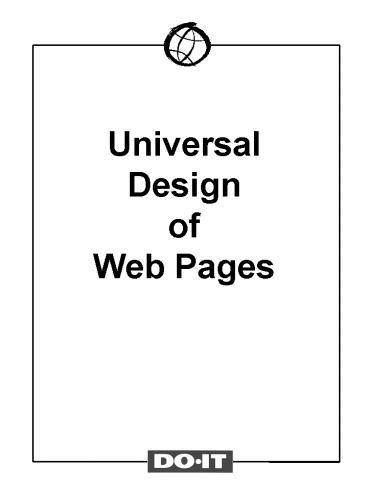Universal Design of Web Pages - PowerPoint PPT Presentation
1 / 15
Title:
Universal Design of Web Pages
Description:
1. List potential barriers to accessing information on World Wide Web pages for ... Video clips are open captioned, providing access to users who can't hear the audio. ... – PowerPoint PPT presentation
Number of Views:41
Avg rating:3.0/5.0
Title: Universal Design of Web Pages
1
Universal Design ofWeb Pages
2
Universal Design of Web Pages Objectives
- 1. List potential barriers to accessing
information on World Wide Web pages for students
with disabilities. - 2. Describe the institutions legal
responsibility to ensure access to information
presented on Web pages. - 3. Describe universal design guidelines for
developing accessible Web pages.
3
Some Internet Visitors
- cannot see graphics.
- cannot hear audio.
- have difficulty with unorganized sites.
- use older equipment with slow connections.
4
Section 504 of the Rehabilitation Act of 1973
No otherwise qualified individual with a
disability shall, solely by reason of his/her
disability, be excluded from the participation
in, be denied the benefits of, or be subjected to
discrimination under any program or activity of a
public entity.
5
Examples of DisabilitiesLow VisionBlindnessH
earing ImpairmentsMobility ImpairmentsMental
Health/Psychiatric ImpairmentsHealth
ImpairmentsLearning Disabilities
6
ADA and the Internet
- Covered entities that use the Internet for
communications regarding their programs, goods,
or services, must be prepared to offer those
communications through accessible means as
well. - - United States Department of Justice (ADA
Accessibility,1997)
7
Universal Design
- The design of products and environments to be
usable by all people, without the need for - adaptation or specialized design.
- Center for Universal Design at North Carolina
State University
8
Provide Multiple Means of
- representation
- expression
- engagement
9
The power of the Web is in its universality.
Access by everyone regardless of disability is
an essential aspect.
- --Tim Berners-Lee, World Wide Web Consortium
10
Web Page Development Accessibility Options
- 1. Avoid inaccessible data types and features.
- 2. Create alternative methods/formats.
11
Example of aWeb Accessibility Statement
- The DO-IT pages form a living document and are
regularly updated. We strive to make them
universally accessible. You will notice that we
minimize the use of graphics and photos, and
provide descriptions of them when they are
included. Video clips are open captioned,
providing access to users who cant hear the
audio. Suggestions for increasing accessibility
of these pages are welcome.
12
Test Your Web Pages
- with different operating systems and monitors.
- with different browsers and with audio and
graphics-loading features turned off. - with a text browser.
- with an accessibility testing program (e.g.,
Bobby). - by accessing the keyboard alone.
13
Policy Guidelines
- Disseminate information
- Train
- Support
- Enforce or reward
- Evaluate and revise
14
Resources
15
Visit The Faculty Room Web site
athttp//www.washington.edu/doit/Faculty/































